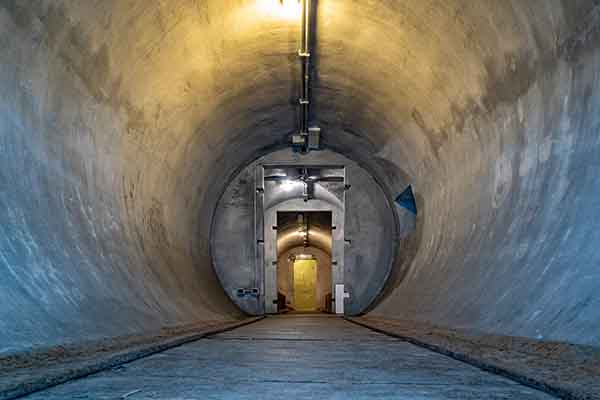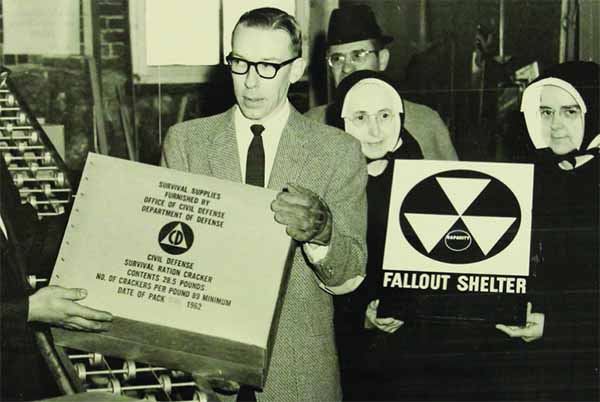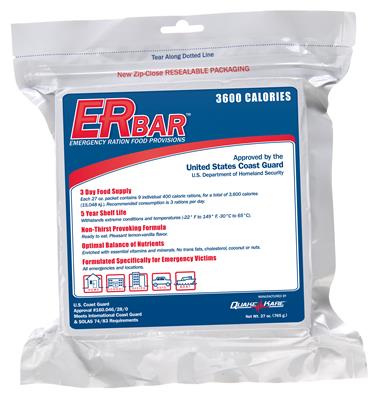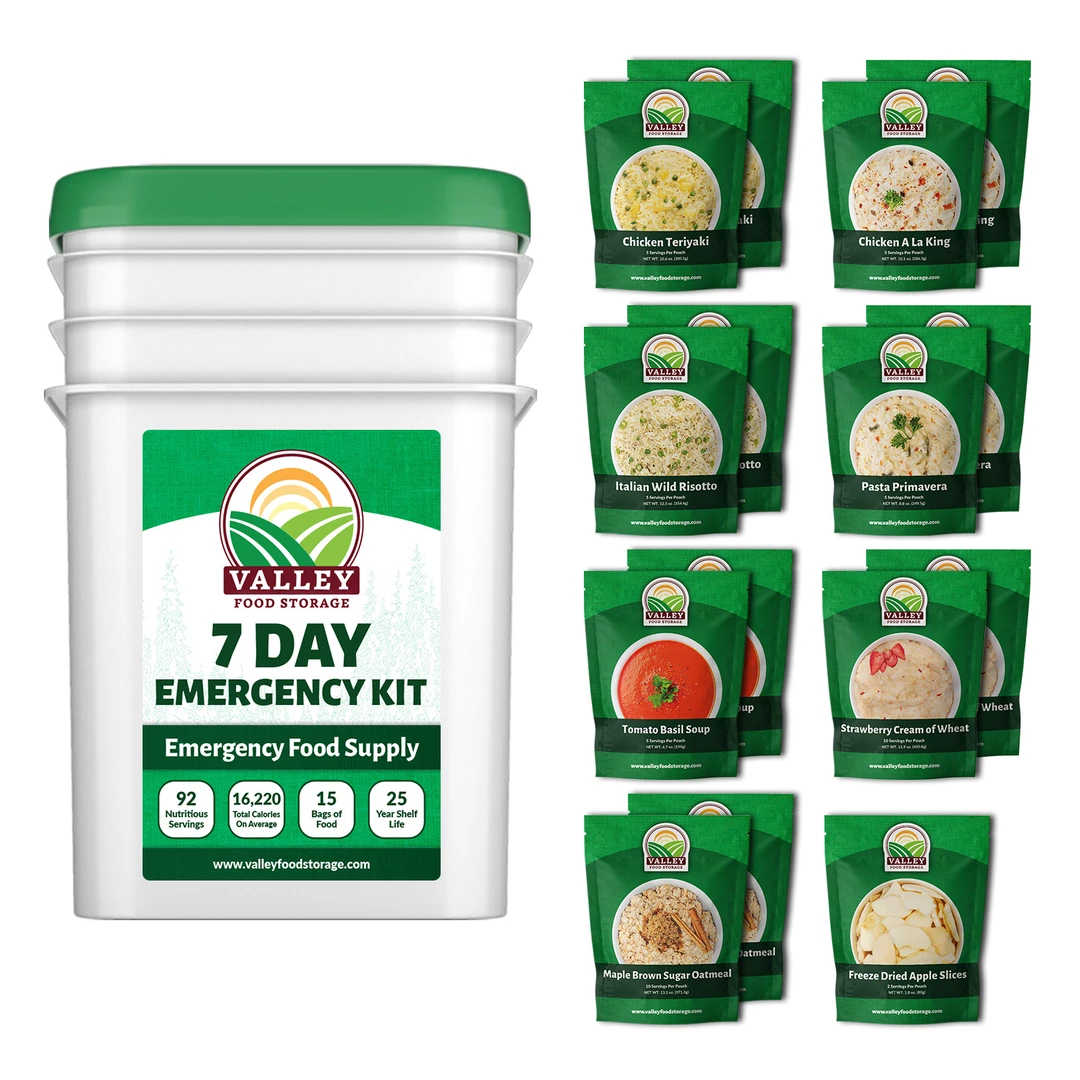Wondering what foods are good to keep in a bunker? It isn’t always as simple as choosing shelf-stable foods, which won’t go bad.
Here are the best bunker foods – and which ones are surprisingly not good choices.
Key Takeaways
Here’s our quick list of the best bunker foods:
- Canned goods
- MREs
- Survival Food Bars
- Meal Bars
- Packaged Emergency Meals
- Freeze Dried Bulk Foods
- Survival Crackers
- Store-Bought Dry Foods and Mixes
- DIY Dehydrated Foods
- Pemmican
- Peanut Butter and PNB Powder
- Texture soy protein (TSP)
- Powdered Milk and Dairy
- Oil
- Seasonings
- Honey
- Candy
- Chocolate
- Coffee
- Drink Mixes
- Vitamins
- Alcohol
What Is a Bunker?

Before we get into the best bunker foods, let’s clarify what a bunker is. Typically, a bunker is defined as a shelter with reinforced walls. It is usually underground and designed to protect against bombs or nuclear fallout.
A bunker is not the same as a safe room in your home. This is important because you will need to store different types of food in a bunker than you would for hunkering down in your home.
Read about the best survival foods.
What Sort of Foods Are Good for Bunkers?
Bunker foods should be shelf-stable. You don’t want to worry about the foods going bad quickly. Because it’s often unsafe to cook in a bunker, you should choose foods that don’t need to be cooked.
Examples of Foods which Are NOT Good for Bunkers
While some of these foods are great for long-term disaster prepping, they are NOT suitable for bunkers because they take so long to cook:
- Dry beans and legumes
- Macaroni and most pastas
- Flour
- Rice
- Whole grains
There’s a reason the Civil Defense fallout shelters from the Cold War era didn’t contain any of these items.
Best Food For Your Bunker
Canned Goods
When it comes to bunker foods, canned goods are probably your best bet. They require no cooking, and you don’t need water to rehydrate them. So long as the can doesn’t get rusty or damaged (don’t store cans directly on the floor or against concrete walls!), canned foods can last forever.
There are a lot of different canned foods you could put in your bunker. Try to get a variety from each of these categories:
- Meals: Such as soups, chili, Spaghetti, couscous salad, stuffed peppers
- Carbs: Canned rice, quinoa, sweet potatoes
- Proteins: Beans, SPAM, tuna, corned beef – best canned meats for long-term storage
- Dairy: Canned cheese, condensed milk
- Fruits and veggies: Pineapple, peas, corn, tomatoes
- Luxury foods: Olives, pudding, pie filling
- Bread: Canned bread
Pro Tip: Go to ethnic grocery stores. They often have a lot of cool canned meals. For example, I love the stuffed eggplant I find in Greek markets.
Also read:
MREs
Meals Ready to Eat (MREs) are entire meals that come in a package. Sometimes they have a flameless heating option that allows you to warm up the meal too.
Traditionally, MREs were issued by the military to soldiers. However, there are now a lot of brands that make meals that they call MREs. Do your research because not all of these are instant – and some are definitely not tasty!
Read: Best brands of affordable MREs
Survival Food Bars
Survival food bars are formulated to be very calorie dense and have a long shelf life. For example:
Keep in mind that survival food bars aren’t meant to taste good: they are meant to keep you alive. They usually taste boring, almost like a bland cookie.
Meal Bars
Unlike survival food bars, meal bars are formulated to taste good. They come in many flavors and nutritional qualities, ranging from glorified candy bars to sports fuel.
Meal bars typically have a 1 to 5-year shelf life, depending on what they are made of.
Packaged Emergency Meals
These meals are made with dehydrated or freeze-dried ingredients. They are also often used as backpacking meals. While they usually require cooking, they cook much faster than if you tried to prepare a meal from scratch.
For example, this Valley Food Storage 7-Day Survival Food Kit has a 25-year shelf life and 2000 calories per day.
The downside is that emergency meals are expensive, although you can get better deals if you buy them in bulk.
Freeze Dried Bulk Foods
Instead of buying meals, you can purchase freeze-dried bulk ingredients to build your own meals. Most emergency food brands sell buckets of staples such as fruit, vegetables, dairy, and meat.
Compared to buying emergency meals, these bulk ingredients are much cheaper than emergency meals. They are generally healthier and have less sodium.
Survival Crackers

Crackers were a staple in Civil Defense fallout shelters. Dry crackers could last for years when stored in airtight tins to keep moisture out. Today, you can buy tins of pilot bread to stockpile in your bunker. Dip them in oil or soup mix for a simple meal.
If you want to go the DIY route, you can make hardtack. When mixed, the ingredients last longer, so you can store it for a long time.
Read: How to make hardtack
No-Cook Carbohydrates
Carbohydrates are great bunker foods because they are shelf-stable and cheap. But most carbs have to be cooked for a long time.
No-cook carbs are a better choice for bunker food. These carbs can be prepared with the cold-soak method: You just soak the dry carbs to soften them. They might taste better warm, but they are OK to make with cold water.
Examples of no-cook carbs for your bunker include:
- Oats: Soak in water or rehydrated milk for 5-20 minutes
- Mashed potatoes: Instant
- Instant sweet potato mix: 5-10 minutes
- Couscous: 5-15 minutes of soaking
- Polenta mix: 5-20 minutes of soaking
- Ramen: 20-30 minutes of soaking
- Rice noodles: Usually takes at least 60 minutes of soaking; they turn into mush but are still edible
Store-Bought Dry Foods and Mixes
There are a lot of dry foods you can find at the supermarket which would be suitable for bunkers. They are often cheap, have long shelf lives, and don’t require cooking.
Here are some excellent options:
- Dehydrated fruits and veggies
- Dry refried bean mixes
- Falafel mixes
- Hummus mixes
- Jerky – learn how to make deer jerky
- Packets of creamy soup (avoid ones with noodles or other ingredients which require cooking)
Storing Dehydrated Foods in a Bunker
The humidity in basement bunkers can easily get to over 50%. Moisture in the air will reabsorb into dehydrated foods, causing them to get wet again. They will eventually start to grow mold or even dangerous bacteria.
Because of this, dehydrated foods won’t last longer than 6 months when stored in their original packaging. You need to repackage them in vapor-proof packaging (such as Mylar bags).
Read: Do dehydrated foods go bad?
DIY Dehydrated Foods
You can get creative with your bunker meals if you have a home dehydrator. You can even dehydrate entire meals. When it’s time to eat, just pour water over them, wait 5-20 minutes, and you’ve got a meal.
Home-dehydrated foods without preservatives must be VERY dry before storing. Like store-bought dehydrated foods, you need to package them in vapor-proof containers.
Pemmican
Pemmican is a survival staple made with fat, dry meat, and sometimes berries or other flavorful additives. It has a long shelf life when kept away from heat and moisture.
Read: How to make pemmican
Peanut Butter and PNB Powder
Peanut butter was a recommended staple for Cold War bunkers, and it is still a good bunker food today. When kept cool, peanut butter will last for a long time without going bad. It’s also one of the cheapest calorie-dense foods you can find.
The fats in peanut butter will eventually start to go rancid. For longer shelf life, you can buy peanut butter powder. It is made by separating the oil and drying the resulting proteins. It’s a great supplement in smoothies or oatmeal. Or you can add oil to it to turn it back into spreadable peanut butter.
Read:
Texture soy protein (TSP)
Also called textured vegetable protein (TVP) is a vegetarian dry protein that typically comes in granules. It works great in chili recipes or sauces. It is very dry and lasts for years if kept dry. Compared to dry meat, it’s also a very cheap source of protein.
Powdered Milk and Dairy
These do wonders to add flavor to meals. For example, you can make your oatmeal with powdered milk. Or add cheese sauce to instant mashed potatoes.
Like with other dry ingredients, powdered milk and dairy can easily succumb to high humidity in bunkers. Emergency food brands sell dry dairy in sealed #10 cans or Mylar bags. They can be pricey but have shelf lives of 10+ years.
Read:
Oil
Olive oil is an excellent bunker food because it contains so many calories. A single tablespoon of olive oil has 119 calories. That’s more than an entire large apple but takes up a fraction of the space.
You probably won’t be cooking or baking with oil in your bunker; it can be used as a supplement to foods. For example, you can add oil to instant carbs. Fat also helps you feel full and satiated.
Read: How to store oil long-term
Seasonings
Bunker foods can get boring very quickly. You’ll want to stockpile as many seasonings as possible to keep up morale. Simply changing up the seasons can make it seem like a new meal.
For example, make rice noodles and canned tuna with soy sauce and chili one day. Add Italian spice mix and mayo the next day.
Here are some good food seasonings for a bunker:
- Soy sauce
- Herbs and spices
- Vinegar
- Shelf-stable mayo packets
- Ketchup
- Mustard
- Hot sauce
Read: How to store herbs and spices long-term
Honey
Honey makes a great food for bunkers because it lasts forever, even without special storage. It is a fantastic source of calories, can be used medicinally, and makes bland foods like oatmeal taste better.
Candy
Candy was another staple bunk food in the Civil Defense bunkers. Like honey, it’s a quick source of energy. It also helps morale, especially if you’ve got kids in the bunker. Just make sure you’ve got an emergency dental kit in your supplies too!
Chocolate
Having a few luxury foods like chocolate in your bunker will do wonders for morale. It can last a very long time when stored correctly.
Coffee
Coffee is another good morale-boosting bunker food. Who wants to go through doomsday without their morning cup of coffee?
There are even hand-operated espresso makers, allowing you to have real coffee in your bunker. But instant coffee is probably your best bet.
Read: Long-term coffee storage
Tea
Remember that tea can be used as a beverage and medicinally. You’ll need to keep tea in airtight containers, preferably with oxygen absorbers, to keep it from oxidizing and losing nutrients.
Read: Store tea bags long term
Drink Mixes
There are a few good reasons to include drink mixes on your list of bunker foods:
- Indefinite shelf life when kept dry
- Mask the taste of musty-tasting (improperly stored) water
- Encourage children to stay hydrated
- May include vitamins
Vitamins
A lot of bunker foods, like dry staples and instant meals, are lacking in nutrients. You can stockpile vitamins and mineral supplements to compensate. They must be kept cool, dry, and in sealed containers.
Read: Do vitamins go bad?
Alcohol
While not technically a food, alcohol makes the list of good bunker foods. It can boost morale, but used as stove fuel and even as general anesthesia in SHTF medicine. And when it’s time to come out of the bunker, alcohol can make a good doomsday barter item.
Is It Safe to Cook Inside a Bunker?
Bunkers are underground or heavily fortified, so they don’t have much airflow. Yes, they have some ventilation (otherwise, you’d suffocate inside), but it’s often not the best. This makes cooking unsafe inside a bunker: you could get carbon monoxide poisoning.
Of course, there are exceptions to this rule. For example, some advanced (i.e., expensive) bunkers have specific ventilation systems that make cooking safe inside them.
Or, you may have a power system for your bunker (such as an underground generator or solar panel system) that would allow you to cook with electricity safely.
Important: Carbon monoxide poisoning is a risk when cooking in any closed-off space, not just bunkers! The same goes for heating with combustible materials. You need ventilation and invest in a good carbon monoxide detector!
Other Problems with Cooking in a Bunker
- Cooking requires energy: You are probably better off saving that energy for other emergency needs
- Produces heat and vapor: Go ahead and try to cook macaroni in a small, sealed-off room, and you’ll see how quickly it gets steamy. If you had to stay in the bunker for a long time, the humidity could cause problems, like causing opened packages of food to get moldy or causing gear failures.
https://www.kshs.org/kansapedia/civil-defense-food-kit/10155 https://www.survivalistboards.com/threads/bunker-cooking-avoid-carb-monoxide.756857/






Diane, OMG, every time I follow a link here, it opens up more great info. Were this to be in a book, it would be voluminous. I don’t know if you even sleep in order to publish this much info on survival.
Whatever you do and however you do it, please know that we on the other end of the ethernet really appreciate both you and your team’s efforts and stand in awe of the shared resources and knowledge.
I pray that we never have to employ them.
Kudo’s
A temporary fix but what I’m looking for is what foods to have temporarily and how to grow food underground. What are the fastest growing foods that you can use alternative lighting sources to grow?
There’s not really a good solution. At the very least, you’d need some grow lights — but how are you going to power them? It would be easier to stockpile foods than try to be self-sufficient while underground.